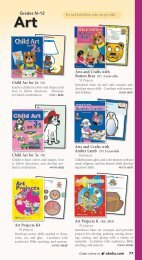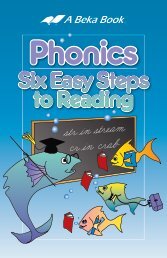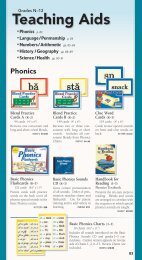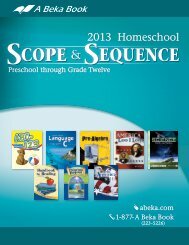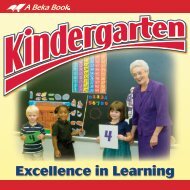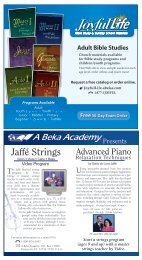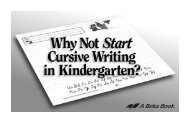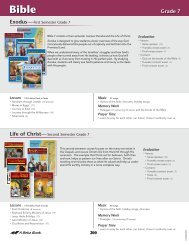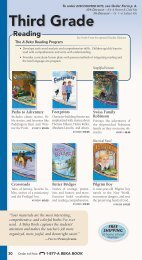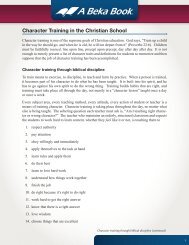ABB Scope and Sequence 2012-First Grade - A Beka Book
ABB Scope and Sequence 2012-First Grade - A Beka Book
ABB Scope and Sequence 2012-First Grade - A Beka Book
You also want an ePaper? Increase the reach of your titles
YUMPU automatically turns print PDFs into web optimized ePapers that Google loves.
<strong>First</strong> <strong>Grade</strong><br />
Language Arts: Phonics<br />
Letters <strong>and</strong> Sounds 1 is a complete phonics practice seatwork book. Each phonics element<br />
necessary for learning to read is systematically reviewed in an appealing way. The many<br />
puzzles, riddles, exercises, <strong>and</strong> illustrations are designed to teach word analysis skills, build<br />
vocabulary, <strong>and</strong> increase reading comprehension.<br />
H<strong>and</strong>book for Reading is an invaluable teaching tool for the application of phonics rules. The<br />
words for students to read are arranged to correlate with the sequence in which diphthongs,<br />
digraphs, consonant blends, etc., are taught. Ample practice <strong>and</strong> thorough review help<br />
students master phonics concepts. The early introduction of short vowels allows students to<br />
read whole words, sentences, <strong>and</strong> stories during the first few weeks of first grade.<br />
Added Enrichment<br />
••<br />
Review games (18)<br />
••<br />
Additional games (11)<br />
•<br />
• During Seatwork:<br />
••<br />
Circle special sounds /mark vowels (15)<br />
••<br />
Write word other than clue word<br />
for special sound (14)<br />
••<br />
Underline root word/circle suffix (12)<br />
••<br />
Write or match rhyming words (6)<br />
••<br />
Add correct special sound to<br />
beginning/middle of word (5)<br />
••<br />
Add suffix to given root word (4)<br />
••<br />
Match special sound to correct word (4)<br />
RED indicates first introduction of content.<br />
Evaluation<br />
••<br />
Oral <strong>and</strong> written phonics tests (32)<br />
Skills Development<br />
•<br />
• Review: long <strong>and</strong> short vowel sounds, consonant sounds<br />
••<br />
Blend consonants with vowels<br />
••<br />
Blend special sounds with vowels<br />
••<br />
Review 47 special sounds <strong>and</strong> clue words learned in K5<br />
hhLearn <strong>and</strong> apply 85 additional special sounds <strong>and</strong> clue words:<br />
special sounds include consonant blends, diphthongs, digraphs, 11<br />
suffixes, 5 prefixes<br />
••<br />
Demonstrate ability to provide other example words that contain<br />
special sounds<br />
hhUnderst<strong>and</strong> that syllables are parts of words<br />
hhBe able to identify root words<br />
hhDemonstrate ability to add suffixes using the rules:<br />
hhWhen a root word ends with a single consonant <strong>and</strong> the vowel<br />
is short, the consonant is usually doubled before adding a suffix<br />
beginning with a vowel.<br />
hhWhen a root word ends with a silent e, the e is usually dropped<br />
before adding a suffix that begins with a vowel<br />
hhDemonstrate ability to add prefixes to root words correctly<br />
hhCorrectly divide words into syllables between:<br />
hhDouble consonants; root words <strong>and</strong> suffixes<br />
hhA vowel <strong>and</strong> a consonant<br />
hhTwo differing consonants<br />
hhPrefixes <strong>and</strong> root words<br />
••<br />
Master phonics rules including:<br />
•<br />
• One- <strong>and</strong> two-vowel rules: When there is one vowel in a word,<br />
it usually says its short sound. When there are two vowels in<br />
a word, the first one says its long sound <strong>and</strong> the second one is<br />
silent.<br />
••<br />
When ll, ff, or ss come at end of word, say sound of the first one;<br />
second one is silent.<br />
••<br />
c-k follows a short vowel (ex.: back)<br />
hhk-e follows a long vowel (ex.: bake)<br />
•<br />
o, u (ex.: key, cat)<br />
••<br />
Suffix -s says “s” or “z”<br />
• c / k rhyme: k comes before i <strong>and</strong> e; c before the other three—a,<br />
20<br />
••<br />
Know <strong>and</strong> apply tips for learning special sounds:<br />
••<br />
“ck in duck” usually follows a short vowel; says the k sound one time<br />
only<br />
••<br />
“e in me” says long e sound when only vowel at end of short word<br />
••<br />
“o in go” says long o sound when only vowel at end of short word<br />
••<br />
“y in fly” says long i sound when at end of short word<br />
••<br />
“ay in pray” usually comes at end of word<br />
h h“oi in coin” usually comes in middle of word or syllable<br />
h h“oy in boy” usually comes at end of word or syllable<br />
h h“kn in knot” comes at beginning of word or syllable; k is silent<br />
h h“gn in gnat” comes at the beginning of a word; g is silent<br />
h h“a in adopt” comes at the beginning of a word (“a” usually says<br />
short “u” at the beginning of any word)<br />
hhSuffix -ed can say “t” or “d,” or it can say “ed” when it comes after<br />
t or d<br />
h h“wh in whale” says “h” when followed by o<br />
h h“tch in patch” usually follows a short vowel<br />
h h“ew” can say “oo” or long “u”<br />
hhWhen c comes before e, i, or y, it says “s”<br />
hhWhen g comes before e, i, or y, it says “j”<br />
h h“dge in fudge” usually follows a short vowel<br />
h h“wr in wrinkle” has a silent w<br />
h h“are in care” can be sounded using two-vowel rule<br />
h h“ure in pure” can be sounded using two-vowel rule<br />
h h“sion in television” is usually found in a word with one s<br />
h h“sion in missionary” s says “sh”; usually followed with another s<br />
h h“or in sailor” comes at end of word with two or more syllables<br />
h h“ar in dollar” comes at end of word with two or more syllables<br />
hhApply phonics concepts to reading<br />
© A <strong>Beka</strong> <strong>Book</strong>
®<br />
®<br />
94951004<br />
®<br />
®<br />
<strong>First</strong> <strong>Grade</strong><br />
Language Arts: Reading<br />
<strong>First</strong> graders learn that there is a whole new world just waiting for them as they advance their reading<br />
skills. The early readers coordinate the reading material with the phonics concepts students<br />
are learning. Students move from stories with simple one- <strong>and</strong> two-vowel words to stories based<br />
on children’s classics, giving them valuable practice in applying phonics skills. Each reader features<br />
delightful, character-building selections that appeal strongly to the interests of first graders.<br />
´~*$7¨<br />
Literary Value<br />
••<br />
31 authors, including well-known writers<br />
such as Aesop, Christina Rossetti, Robert<br />
Louis Stevenson, <strong>and</strong> Lewis Carroll<br />
••<br />
Character-building <strong>and</strong> patriotic story<br />
themes such as honesty, integrity, courage,<br />
kindness, industry, forgiveness, <strong>and</strong><br />
unselfishness<br />
Materials<br />
•<br />
• Readers (10) containing:<br />
••<br />
Short stories <strong>and</strong> plays (204)<br />
••<br />
Poems (140)<br />
••<br />
Primary Bible Reader containing<br />
selected Scripture reading<br />
(24 lessons)<br />
Evaluation<br />
••<br />
Weekly oral reading grade<br />
RED indicates first introduction of content.<br />
Reading Skills Development<br />
••<br />
Read <strong>and</strong> decode (sound out) words by applying phonics sounds<br />
<strong>and</strong> rules<br />
••<br />
Strive for increasing:<br />
••<br />
Accuracy, correct enunciation, fluency<br />
hhPhrasing<br />
••<br />
Alertness to punctuation; good expression; comprehension<br />
••<br />
Appropriate pace for grade level<br />
••<br />
Volume; poise<br />
••<br />
Follow along as others read orally<br />
••<br />
Receive differentiated instruction with ability grouping<br />
Readers<br />
••<br />
Fun with Pets—Begins with simple one-vowel words <strong>and</strong> progresses<br />
to stories with two-vowel words<br />
••<br />
Tiptoes—39 stories <strong>and</strong> 15 poems; uses words with special sounds<br />
from Basic Phonics Charts 6 & 7<br />
••<br />
Stepping Stones—19 stories <strong>and</strong> 13 poems; reinforces special<br />
sounds from Basic Phonics Charts 8 & 9<br />
••<br />
Secrets & Surprises—14 stories <strong>and</strong> 30 poems; covers Charts 8–11<br />
••<br />
The Bridge <strong>Book</strong>—9 stories <strong>and</strong> 74 poems; covers Charts 6–13<br />
••<br />
Animals in the Great Outdoors—25 stories <strong>and</strong> 6 poems; covers<br />
Charts 8–13 (Group I, Advanced Group 1 reader)<br />
••<br />
Kind & Brave—19 stories; covers Charts 10–11<br />
••<br />
Aesop’s Fables—28 stories; covers Charts 8–11<br />
••<br />
Strong & True—22 stories <strong>and</strong> 7 poems; covers Charts 12–13<br />
••<br />
Down by the Sea—16 stories <strong>and</strong> 4 poems; covers all charts; for<br />
Gr. 1 at end of the year<br />
••<br />
Primary Bible Reader—24 Class Reading lessons including selected<br />
stories <strong>and</strong> passages from Genesis, Luke, <strong>and</strong> John<br />
Comprehension, Discussion, & Analysis<br />
Skills Development<br />
•<br />
• Answer factual <strong>and</strong> interpretive questions for most stories <strong>and</strong> poems<br />
••<br />
Answer inferential comprehension <strong>and</strong> discussion questions<br />
••<br />
Read sight words; challenging words<br />
••<br />
Complete integrated phonics, language, <strong>and</strong> reading skills activities<br />
such as:<br />
••<br />
Marking short <strong>and</strong> long vowel sounds<br />
••<br />
Circling special sounds<br />
••<br />
Adding correct special sounds to complete words<br />
••<br />
Reading clues to solve puzzles<br />
••<br />
Filling in the blank with correct word / phrase to complete a sentence<br />
••<br />
Matching pictures with descriptive words<br />
hhMatching pictures with descriptive phrases or sentences<br />
hhChoosing correct sentences for telling events in story<br />
•<br />
• Choosing correct picture to answer comprehension questions about<br />
the story<br />
hhNumbering pictures in correct story sequence<br />
hhMarking root words <strong>and</strong> suffixes<br />
hhIdentifying parts of compound words<br />
hhForming contractions<br />
hhMatching rhyming words; writing rhyming words<br />
hhMatching picture with correct homonym<br />
hhReading comprehension question <strong>and</strong> circling correct answer<br />
21<br />
© A <strong>Beka</strong> <strong>Book</strong>
<strong>First</strong> <strong>Grade</strong><br />
Language Arts: Language<br />
Designed for use during independent work times, the work-text Language 1 provides daily<br />
exercises to help students increase thinking skills, improve reading comprehension, <strong>and</strong><br />
develop creative writing ability. By the end of the year, students will be able to write in<br />
complete sentences, capitalize the first word of a sentence, capitalize the days <strong>and</strong> months,<br />
place a period at the end of a sentence, know <strong>and</strong> use suffixes <strong>and</strong> prefixes, <strong>and</strong> alphabetize<br />
words.<br />
RED indicates first introduction of content.<br />
Grammar<br />
•<br />
• Capitalization:<br />
••<br />
<strong>First</strong> word in the sentence<br />
hhDays of week <strong>and</strong> months of year<br />
••<br />
The word I<br />
••<br />
Punctuation: correctly use period at end of a telling sentence<br />
••<br />
The sentence: always begin with capital letter<br />
••<br />
Word study <strong>and</strong> diction:<br />
hhFind root words<br />
hhAdd suffixes <strong>and</strong> prefixes to root words<br />
hhDetermine number of syllables<br />
•<br />
• Recognize <strong>and</strong> use:<br />
hhCompound words; rhyming words<br />
••<br />
Opposite words (antonyms)<br />
hhSame-meaning words (synonyms); same-sounding words<br />
(homonyms)<br />
hhContractions<br />
hhDivide a word into syllables between:<br />
hhDouble consonants<br />
hhRoot words <strong>and</strong> suffixes<br />
hhA vowel <strong>and</strong> a consonant<br />
hhTwo consonants that are not alike<br />
hhPrefixes <strong>and</strong> root words<br />
hhAlphabetize words<br />
hhComprehend reading material <strong>and</strong> answer questions<br />
Composition<br />
hhWrite:<br />
hhInteresting sentences, paragraphs<br />
hhShort narratives<br />
•<br />
• Compositions about designated topics (9)<br />
••<br />
Copying / completing sentences (49)<br />
••<br />
Writing original sentences (39)<br />
Added Enrichment<br />
•<br />
• During Seatwork:<br />
••<br />
Copy sentences (54)<br />
••<br />
Finish sentences (9)<br />
••<br />
Write original sentences (19)<br />
••<br />
Write compositions about designated topics (12)<br />
••<br />
During Science, History, <strong>and</strong> Health:<br />
••<br />
Creative writing exercises (14)<br />
Language Arts: Cursive Writing<br />
Writing with Phonics 1 is designed for use as a first-grade cursive writing worktext.<br />
Students learn the proper formation <strong>and</strong> slant of letters <strong>and</strong> the correct<br />
spacing between letters, words, <strong>and</strong> sentences. Through daily writing exercises,<br />
students will practice <strong>and</strong> review what they are learning in phonics, beginning with<br />
single letters <strong>and</strong> progressing to special sounds, words, <strong>and</strong> sentences.<br />
Added Enrichment<br />
••<br />
Animal booklet compilation<br />
Evaluation<br />
••<br />
Tests (31)<br />
RED indicates first introduction of content.<br />
Skills Development<br />
•<br />
• Achieve good writing position:<br />
••<br />
Sitting properly in desk<br />
••<br />
Holding pencil correctly<br />
••<br />
Slanting paper correctly<br />
••<br />
Review correct formation for all small letters, numbers 0–9, <strong>and</strong><br />
the 12 capital letters learned in K5<br />
hhLearn formation for remaining 14 capital letters<br />
22<br />
••<br />
Perfect writing skills for a good, overall appearance:<br />
••<br />
Forming troublesome letters correctly<br />
••<br />
Placing letters correctly on the lines<br />
••<br />
Using proper spacing between letters <strong>and</strong> words<br />
••<br />
Slanting letters properly<br />
••<br />
Writing slowly <strong>and</strong> carefully<br />
••<br />
Making smooth connections between letters, troublesome letters,<br />
blends<br />
••<br />
Using key strokes: slant, loops, tails, humps<br />
••<br />
Evaluate writing for personal improvement<br />
© A <strong>Beka</strong> <strong>Book</strong>
<strong>First</strong> <strong>Grade</strong><br />
Language Arts: Spelling & Poetry<br />
In Spelling <strong>and</strong> Poetry 1, first graders apply the phonics concepts they are<br />
currently learning as they master the spelling of approximately 420 words. Most<br />
of the words in Spelling <strong>and</strong> Poetry 1 are arranged phonetically, which teaches<br />
students to recognize basic spelling patterns. They will learn sight words, contractions,<br />
<strong>and</strong> abbreviations that they will encounter frequently in their reading<br />
<strong>and</strong> writing. <strong>First</strong> graders will also learn eight poems that will help them develop<br />
their oral speaking skills while deepening their appreciation for poetry.<br />
RED indicates first introduction of content.<br />
Added Enrichment<br />
••<br />
Spelling lists (30):<br />
••<br />
Total words (420)<br />
•<br />
• Organized by special sounds<br />
••<br />
Worksheet activities reinforce new<br />
concepts (112)<br />
••<br />
Homework sheets include spelling list<br />
<strong>and</strong> helpful hints or special sounds<br />
featured in the list (30)<br />
••<br />
Spelling games (16)<br />
Evaluation<br />
••<br />
Spelling words tested in 30 of the 32<br />
phonics tests<br />
Spelling Skills Development<br />
hhMaster spelling lists including sight words, abbreviations, <strong>and</strong><br />
contractions<br />
hhApply spelling <strong>and</strong> phonics concepts through daily:<br />
hhTeacher-directed oral practice<br />
hhIndependent written practice<br />
hhHear spelling words used in sentences <strong>and</strong> clearly picture each<br />
word’s meaning<br />
hhLearn to differentiate between words that sound alike<br />
hhUse spelling words in creative writing exercises<br />
hhLearn spelling rules:<br />
hhKnow: one- <strong>and</strong> two-vowel rules; k comes before i <strong>and</strong> e; c comes<br />
before a, o, u<br />
hhCorrectly use at end of word:<br />
hhDouble consonants ll, ff, or ss<br />
hhVowels e, o, or y<br />
hhck after a short vowel; ke after a long vowel<br />
hhDouble a consonant before adding a suffix that begins with a vowel<br />
hhDrop the silent e<br />
Worksheet Activities:<br />
••<br />
Marking special phonics sounds<br />
hhMarking roots <strong>and</strong> suffixes<br />
••<br />
Completing words <strong>and</strong> sentences<br />
hhArranging words alphabetically<br />
hhIdentifying misspelled words, opposites, rhyming words<br />
hhCategorizing words by special phonics sounds<br />
hhSolving word puzzles <strong>and</strong> riddles<br />
••<br />
Associating words with pictures<br />
hhMatching words with their meaning<br />
hhCombining root words <strong>and</strong> suffixes -ing, -ed<br />
Poetry Skills Development<br />
hhMemorize 8 lyrical poems<br />
•<br />
•<br />
•<br />
• Develop appreciation of poetry<br />
• Perform in front of an audience<br />
• Recite in unison<br />
hhDevelop appropriate expression <strong>and</strong> volume<br />
hhImprove comprehension through thinking questions<br />
hhLearn terms such as title <strong>and</strong> author<br />
••<br />
Maintain interest <strong>and</strong> increase comprehension through added learning<br />
features such as actions <strong>and</strong> h<strong>and</strong> motions<br />
Arithmetic<br />
Using delightful themes <strong>and</strong> full-color illustrations, Arithmetic 1 presents concepts<br />
in an orderly manner, building on prior learning <strong>and</strong> including consistent year-long<br />
review. Concepts include counting, writing <strong>and</strong> reading numbers, place value, addition<br />
<strong>and</strong> subtraction, money, graphs, measurements, time, temperature, <strong>and</strong> fractions.<br />
Applications to real-life situations <strong>and</strong> daily thinking questions stretch the students’<br />
reasoning ability.<br />
RED indicates first introduction of content.<br />
Added Enrichment<br />
••<br />
Thematic units: zoo, farm, ocean,<br />
spring<br />
••<br />
Introductory song <strong>and</strong> / or poem for<br />
each unit<br />
Evaluation<br />
••<br />
Written tests (31)<br />
••<br />
Daily timed skills-development<br />
exercises (136)<br />
••<br />
Oral tests (31): combinations,<br />
answers, <strong>and</strong> complete instructions<br />
for oral tests in daily lesson plans<br />
Numbers<br />
••<br />
Recognizing numbers:<br />
••<br />
1–100<br />
hh101–1,000<br />
23<br />
••<br />
Underst<strong>and</strong>ing concepts:<br />
••<br />
1–100<br />
hh101–1,000<br />
••<br />
Counting:<br />
••<br />
Money<br />
••<br />
Ordinal numbers: 1–10<br />
Arithmetic cont. p. 24<br />
© A <strong>Beka</strong> <strong>Book</strong>
<strong>First</strong> <strong>Grade</strong><br />
Arithmetic cont.<br />
Numbers cont.<br />
hhForward <strong>and</strong> backward by ones, twos, fives, <strong>and</strong> tens<br />
hhForward by twenty-fives<br />
hhBy threes from 3 to 36<br />
hhTally marks<br />
hhRoman numerals 1–10<br />
hhBy even <strong>and</strong> odd numbers<br />
hhOrdinal numbers: 11–20<br />
••<br />
Writing numbers:<br />
••<br />
By ones, twos, fives, <strong>and</strong> tens to 100<br />
•<br />
• Words one–twelve<br />
hhTo 1,000<br />
hhBy threes to 36<br />
hhUsing tally marks<br />
•<br />
•<br />
••<br />
Before/after<br />
•<br />
•<br />
• Comparing:<br />
• Greater/less, greatest /least<br />
• By ones, twos, fives, tens<br />
• Using symbols > <strong>and</strong> < to show greater than <strong>and</strong> less than<br />
hhBefore <strong>and</strong> after: by twos, fives, tens<br />
hhPlace value:<br />
hhIllustrating numbers <strong>and</strong> place value with objects<br />
hhUnderst<strong>and</strong>ing hundreds, tens, ones<br />
hhOrdering four numbers<br />
hhAddition with carrying<br />
Addition<br />
••<br />
Review of addition families 1–10<br />
hhLearn addition families 11–18<br />
hhHorizontal <strong>and</strong> vertical form<br />
••<br />
Oral or written<br />
•<br />
• Addition “twins” (concept of commutative principle)<br />
hhTimed mastery<br />
hhMissing terms<br />
•<br />
•<br />
• Word problems:<br />
• Oral<br />
hhWritten<br />
hhDoubles +1<br />
hhWriting addition number sentences<br />
hhAddends:<br />
hhColumn addition with up to five single-digit addends<br />
hhTwo- <strong>and</strong> three-digit problems without carrying<br />
hhCarrying two- <strong>and</strong> three-digit numbers with carrying to the tens’<br />
<strong>and</strong> hundreds’ places<br />
hhMental arithmetic:<br />
hhProblems with up to 5 single-digit numbers<br />
hhProblems combining single-digit addition <strong>and</strong> subtraction up to<br />
3 numbers<br />
••<br />
Adding coins<br />
Subtraction<br />
••<br />
Recognizing symbol: – (minus)<br />
hhSubtraction families 1–18:<br />
hhVertical <strong>and</strong> horizontal form<br />
•<br />
• Written, oral<br />
hhSubtracting coins<br />
hhTimed mastery<br />
hhMissing terms<br />
RED indicates first introduction of content.<br />
hhMental arithmetic: problems combining single-digit addi tion <strong>and</strong><br />
subtraction up to 3 numbers<br />
hhWriting subtraction number sentences<br />
hhSubtracting:<br />
hhOne-digit problems<br />
hhTwo- <strong>and</strong> three-digit problems without borrowing<br />
hhWord problems: oral, written<br />
Multiplication<br />
••<br />
Building blocks:<br />
hhRepeated addition<br />
hhObjects to multiply<br />
•<br />
• Counting by twos, fives, tens<br />
hhCounting by threes<br />
hhConcept of multiplication<br />
hhWriting a multiplication fact<br />
Fractions<br />
hhConcept of fractions<br />
hhBuilding blocks: equal parts<br />
••<br />
Parts of a whole:<br />
•<br />
• One half<br />
hhOne fourth, one third<br />
hhParts of a group: one half, one fourth, one third<br />
hhComparing one half, one fourth, one third<br />
hhLeast to greatest<br />
Problem Solving & Applications<br />
••<br />
Building blocks: oral word problems<br />
hhWritten word problems<br />
hhSolving word problems:<br />
hhAddition, subtraction, money<br />
hhIllustrating story problems<br />
hhCreating story problems<br />
hhExtra facts; missing facts<br />
hhChoosing the operation<br />
hhApplications:<br />
hhTemperature; time<br />
hhWeight; length; money<br />
hhNumber puzzles; graphs<br />
hhCalendars; maps<br />
hhThinking logically: patterns; thinking caps; sequencing; clue words<br />
Time<br />
•<br />
• Clock: face, hour <strong>and</strong> minute h<strong>and</strong>s<br />
••<br />
Reading <strong>and</strong> writing time:<br />
••<br />
O’clock (:00), half past (:30), quarter past (:15)<br />
hhQuarter till (:45)<br />
hhFive-minute intervals<br />
hhA.M. <strong>and</strong> P.M.<br />
••<br />
Calendar: months, days, date, rhyme<br />
hhMeasures of time<br />
24<br />
Arithmetic cont. p. 25<br />
© A <strong>Beka</strong> <strong>Book</strong>
®<br />
®<br />
95311005<br />
®<br />
<strong>First</strong> <strong>Grade</strong><br />
1<br />
®<br />
History & Geography Series<br />
Fourth<br />
Edition<br />
Arithmetic cont.<br />
Money<br />
••<br />
Recognize coin <strong>and</strong> value: penny, nickel, dime, quarter, half dollar,<br />
dollar<br />
••<br />
Count:<br />
••<br />
Pennies, dimes, nickels<br />
hhQuarters, half dollars<br />
••<br />
Add:<br />
••<br />
Pennies, dimes <strong>and</strong> pennies, nickels <strong>and</strong> pennies<br />
hhQuarters <strong>and</strong> pennies, dimes <strong>and</strong> nickels<br />
hhCount: combinations of coins, coins in mixed order<br />
hhAdding <strong>and</strong> subtracting money<br />
••<br />
Recognize symbol: ¢ (cent)<br />
••<br />
Word problems: oral <strong>and</strong> written<br />
Measures<br />
•<br />
• Word problems: oral <strong>and</strong> written<br />
••<br />
Temperature: reading <strong>and</strong> writing degrees<br />
••<br />
Length:<br />
hhInch, foot, yard, centimeter<br />
RED indicates first introduction of content.<br />
••<br />
Weight:<br />
hhOunce, pound<br />
hhComparing weights<br />
hhDozen, half dozen<br />
hhCapacity: cup, pint, quart, gallon<br />
hhPerimeter of a rectangular object<br />
Graphing, Statistics, Probability<br />
hhGraphs:<br />
hhHorizontal bar graphs: scales by 2s, 10s, 5s, <strong>and</strong> 3s<br />
hhPictograph<br />
hhGraphing tally marks<br />
Geometry<br />
••<br />
Recognize shapes: circle, square, rectangle, triangle<br />
hhSymmetry<br />
hhShapes in a grid<br />
hhPerimeter of a rectangle<br />
´¡?*%#¨<br />
My America <strong>and</strong> My World<br />
History & Geography<br />
In My America <strong>and</strong> My World, students will learn how our country was founded <strong>and</strong><br />
what our basic freedoms are. They meet several famous American patriots <strong>and</strong> take<br />
a trip across America. Good citizenship is emphasized <strong>and</strong> reading skills are developed.<br />
In addition, students will learn new patriotic songs <strong>and</strong> be introduced to major<br />
countries <strong>and</strong> U.S. Territories. America: Our Great Country, Children of the World,<br />
<strong>and</strong> Community Helpers are used in correlation with My America <strong>and</strong> My World.<br />
RED indicates first introduction of content.<br />
Added Enrichment<br />
••<br />
Vocabulary boxes to point out difficult<br />
words<br />
••<br />
Activities such as:<br />
••<br />
Artistic projects<br />
•<br />
•<br />
•<br />
country<br />
•<br />
• Learning foreign words <strong>and</strong> phrases<br />
• Listening to classical music<br />
• Reading stories by writers of given<br />
• Suggested creative writing topics<br />
America<br />
••<br />
U.S. flag:<br />
••<br />
History<br />
hhMeaning of colors<br />
hhMeaning of Pledge of Allegiance<br />
hhAmerica’s freedoms<br />
••<br />
Symbols such as:<br />
hhGreat Seal of the U.S., American eagle, Liberty Bell, Uncle Sam<br />
••<br />
Statue of Liberty, U.S. coins<br />
hhGreat U.S. documents: Declaration of Independence, Constitution,<br />
Bill of Rights<br />
••<br />
Great people of America:<br />
••<br />
Pilgrims (<strong>First</strong> Thanksgiving)<br />
••<br />
George Washington, Abraham Lincoln<br />
hhPaul Revere, Benjamin Franklin<br />
hhAmerica grows by communication <strong>and</strong> travel: telephone, mail, television,<br />
radio; changes in transportation<br />
••<br />
American places such as:<br />
••<br />
Washington, D.C.<br />
hhPlymouth Rock, Fort McHenry<br />
h hWilliamsburg, Virginia; Mississippi River<br />
hhMount Rushmore, Yellowstone National Park, Gr<strong>and</strong> Teton National<br />
Park, Rocky Mountains, Gr<strong>and</strong> Canyon, Yosemite National Park<br />
••<br />
Patriotic songs:<br />
••<br />
“My Country, ‘Tis of Thee”<br />
••<br />
“The Star-Spangled Banner”<br />
h h“America the Beautiful”<br />
The World<br />
•<br />
• Countries <strong>and</strong> territories:<br />
••<br />
Mexico, Peru, Engl<strong>and</strong>, The Netherl<strong>and</strong>s, Israel, Italy, Kenya, China,<br />
Australia<br />
hhVirgin Isl<strong>and</strong>s, Puerto Rico, Bahamas, Norway, France, Germany,<br />
Switzerl<strong>and</strong>, Egypt, India, Guam, American Samoa<br />
25<br />
History & Geography cont. p. 26<br />
© A <strong>Beka</strong> <strong>Book</strong>
<strong>First</strong> <strong>Grade</strong><br />
History & Geography cont.<br />
RED indicates first introduction of content.<br />
Geography Study<br />
••<br />
Continents: North America, South America, Africa, Europe,<br />
Australia, Asia<br />
••<br />
Globe<br />
••<br />
Oceans: Atlantic <strong>and</strong> Pacific<br />
••<br />
Cardinal directions <strong>and</strong> compass rose<br />
••<br />
What is an isl<strong>and</strong>?<br />
hhLocation of 19 specific states in America<br />
hhNorth <strong>and</strong> South Poles<br />
hhHome state, neighboring states<br />
hhThirteen original colonies<br />
hhEquator<br />
hhGulf of Mexico, Mississippi River, Rocky Mountains, Gr<strong>and</strong> Canyon,<br />
Death Valley, Great Plains, Yosemite National Park<br />
Community Helpers<br />
•<br />
• Pastor<br />
••<br />
Firefighter<br />
••<br />
Doctor<br />
••<br />
Dentist<br />
••<br />
Waiter / Waitress<br />
••<br />
Postal Employee<br />
• Teacher<br />
• Police Officer<br />
• Nurse<br />
• Farmer<br />
• Baker<br />
• Mayor<br />
Science<br />
The colorfully illustrated science text Discovering God’s World presents God as the<br />
Master Designer of the world around us. The studies of plants, animals, insects,<br />
energy, health, the seasons, <strong>and</strong> the five senses provide an excellent introduction to<br />
science, with the emphasis on building student interest <strong>and</strong> augmenting students’<br />
reading skills. H<strong>and</strong>s-on activities <strong>and</strong> demonstrations also increase students’ comprehension<br />
of basic science concepts.<br />
Added Enrichment<br />
•<br />
• Additional h<strong>and</strong>s-on learning activities<br />
••<br />
Lesson activities (24)<br />
••<br />
Additional activities (47)<br />
RED indicates first introduction of content.<br />
Health & Human Biology<br />
••<br />
Special to God: five senses <strong>and</strong> sense organs<br />
hhH<strong>and</strong>s: fingerprints<br />
hhHair:<br />
h<br />
hhRoot, pigment<br />
h<br />
h<br />
•<br />
••<br />
Tongue:<br />
•<br />
h Hair types, skin, oil gl<strong>and</strong>, follicle<br />
h Eyes: placement in skull; eyelids, eyelashes, tears<br />
h Ears: outer ear, eardrum; vibrate<br />
• Nose: nostrils; sneezing<br />
• Taste buds: sour, salty, bitter, sweet<br />
hhSpeaking<br />
••<br />
Skin:<br />
hhExperiencing cold, warmth<br />
••<br />
Experiencing tickles, pain<br />
hhPores, “goose-bumps,” proper care of skin<br />
Activities & Demonstrations:<br />
hhComparing thumb prints<br />
hhDiscovering how sound travels<br />
hhSeeing how senses work together<br />
Energy<br />
hhWater: force, push, pull<br />
hhAir: wind, provides push<br />
hhWind: moving air, force<br />
hhSimple machines: wheels, ramps, levers<br />
•<br />
• Magnets: attract (pull), repel (push)<br />
Activities & Demonstrations:<br />
hhMaking a balloon jet<br />
hhSeeing how wheels help<br />
hhHaving a ramp race<br />
hhUsing a lever lifter<br />
••<br />
Discovering what magnets pick up<br />
Animals<br />
••<br />
Instinct<br />
hhReproduce after their kind<br />
hhBabies that are born drink mother’s milk: kangaroo, opossum<br />
hhBabies that hatch do not drink mother’s milk: frogs, tadpoles, chicks,<br />
alligators, snakes<br />
••<br />
God’s wonderful plan:<br />
••<br />
Elephants: ears, trunk, tusk<br />
••<br />
Ducks: sac of oil, webbed feet, bill<br />
••<br />
Turtles:<br />
••<br />
Shell<br />
hhJaws; l<strong>and</strong> turtles, water turtles<br />
hhOwls: herbivores, carnivores, omnivores; eyes, head rotation;<br />
feathers, talons<br />
Activities & Demonstrations:<br />
hhRaising tadpoles<br />
hhConducting the elephant ear experiment<br />
hhObserving oil on a duck<br />
26<br />
Science cont. p. 27<br />
© A <strong>Beka</strong> <strong>Book</strong>
<strong>First</strong> <strong>Grade</strong><br />
Science cont.<br />
Insects<br />
••<br />
Importance of insects<br />
hhInsect identification: head, thorax, abdomen, six legs<br />
•<br />
• Ants: workers, queen<br />
Activities & Demonstrations:<br />
hhObserving a caterpillar change into a butterfly<br />
•<br />
• Making an insect zoo; ant farm<br />
Plants<br />
hhUses for plants: oxygen, food, medicine, building<br />
hhParts of the plant: roots, stem, flowers, cones, seeds<br />
hhReproduce after their kind<br />
Activities & Demonstrations:<br />
hhOpening a seed<br />
••<br />
Germinating seeds<br />
hhGrowing a plant from root<br />
hhWatering up a stem<br />
Seasons<br />
•<br />
• God made seasons<br />
••<br />
Winter: rest, hibernate<br />
••<br />
Spring: new life<br />
••<br />
Summer: grow<br />
••<br />
Fall: get ready<br />
hhA sunflower’s year<br />
hhA squirrel’s year<br />
Activities & Demonstrations:<br />
hhBringing some twigs to life<br />
hhFinding air in water <strong>and</strong> soil<br />
hhMaking a bird feeder<br />
••<br />
Planting a bean garden<br />
RED indicates first introduction of content.<br />
Health<br />
Health, Safety, & Manners 1 is an interesting <strong>and</strong> attractive health reader that<br />
introduces first graders to the importance of good health habits <strong>and</strong> gives God the<br />
glory for the way He has designed us. Students will learn about nutrition, exercise,<br />
proper sleep habits, good posture, safety habits, <strong>and</strong> manners. Activities <strong>and</strong><br />
checklists help students apply good principles of health, safety, <strong>and</strong> manners.<br />
RED indicates first introduction of content.<br />
Added Enrichment<br />
••<br />
H<strong>and</strong>s-on learning activities in<br />
student book, Teacher Edition, <strong>and</strong><br />
daily lesson plans (16)<br />
••<br />
Growing Tall growth chart<br />
••<br />
Checksheets: My Health, My Safety,<br />
My Manners<br />
Health<br />
••<br />
Growing tall<br />
hhForming good habits<br />
••<br />
Eating good foods:<br />
•<br />
• Kinds of foods<br />
hhA good breakfast, a good snack<br />
••<br />
Good eating habits:<br />
hhEating meals same time every day<br />
••<br />
Washing h<strong>and</strong>s before eating<br />
••<br />
Drinking milk every day<br />
••<br />
Eating different kinds of food<br />
hhWashing fresh fruits <strong>and</strong> vegetables before eating<br />
••<br />
Limiting sugar <strong>and</strong> c<strong>and</strong>y<br />
hhTaking small bites <strong>and</strong> chewing food well<br />
••<br />
Exercising each day:<br />
hhFun exercises for children (8)<br />
••<br />
Benefits of fresh air <strong>and</strong> sunshine<br />
••<br />
Good exercise habits:<br />
••<br />
Getting exercise every day <strong>and</strong> playing outside in fresh air<br />
••<br />
Helping with work at home<br />
hhNot playing hard right after a meal<br />
hhResting from play<br />
hhGetting right amount of rest:<br />
hhGood sleeping habits:<br />
hhPre-bedtime activities<br />
h<br />
h Wearing clean pajamas<br />
hhGoing to bed early <strong>and</strong> at same time each night; sleeping until<br />
rested; good sleeping conditions; going right to sleep<br />
hhBuilding good posture:<br />
h<br />
hhGood posture habits:<br />
h<br />
h<br />
•<br />
•<br />
•<br />
••<br />
Proper care for cuts<br />
•<br />
h Benefits of good posture<br />
h How to st<strong>and</strong> straight <strong>and</strong> tall; proper way to sit in a chair<br />
h Well-fitting shoes; proper walking habits<br />
• Taking care of the body:<br />
• Good skin <strong>and</strong> hair habits:<br />
• Bathing often with warm water <strong>and</strong> soap<br />
• Washing h<strong>and</strong>s: before eating; after using bathroom; after playing<br />
outside; after h<strong>and</strong>ling animals<br />
hhHow to dry off effectively<br />
••<br />
Shampooing dirty hair<br />
hhProper use <strong>and</strong> maintenance of your comb <strong>and</strong> brush<br />
hhKeeping pets away from your face<br />
hhKeeping fingernails <strong>and</strong> toenails clean <strong>and</strong> trimmed<br />
••<br />
Not biting fingernails<br />
••<br />
Keeping fingers out of mouth<br />
27<br />
Health cont. p. 28<br />
© A <strong>Beka</strong> <strong>Book</strong>
<strong>First</strong> <strong>Grade</strong><br />
Health cont.<br />
Health cont.<br />
••<br />
Eyes:<br />
••<br />
Purpose; protection<br />
hhGood eye-care habits:<br />
hhReading in a well-lighted place<br />
hhNot rubbing your eyes<br />
hhNot running while holding sharp things<br />
hhProtecting eyes from sun or other bright lights<br />
hhGetting proper rest<br />
hhGetting eye check-ups by a doctor<br />
hhKeeping eye glasses clean<br />
••<br />
Ears:<br />
••<br />
Protection: wax, hairs<br />
hhGood ear-care habits:<br />
hhProper washing of ears<br />
hhNot putting objects in ears<br />
hhProtecting ears from getting hit; from cold <strong>and</strong> wind<br />
hhGoing to a doctor for chronic earaches<br />
••<br />
Nose:<br />
••<br />
Purpose; protection from germs<br />
••<br />
Good health habits:<br />
•<br />
• Protecting others from your coughing or sneezing; proper use<br />
of tissues<br />
••<br />
Teeth:<br />
hhInstructions for proper brushing<br />
••<br />
Good tooth-care habits:<br />
••<br />
Drinking plenty of milk every day<br />
••<br />
Limiting sugar<br />
••<br />
Not cracking nuts with teeth<br />
••<br />
Brushing correctly<br />
••<br />
Getting regular dental checkups<br />
••<br />
Keeping h<strong>and</strong>s away from face<br />
hhKeeping pencils out of mouth<br />
hhNot eating from someone else’s food<br />
hhTaking care of clothing:<br />
hhGood clothing-care habits:<br />
hhChanging from school clothes to play clothes<br />
hhLearning what to do with clothes after taking them off; clothes<br />
that need to be mended; dirty clothes<br />
hhPutting on clean underclothes daily<br />
hhTaking coat or raincoat off when inside<br />
hhTaking care of the home<br />
Safety<br />
•<br />
• At home:<br />
••<br />
Ways to prevent falls<br />
••<br />
Good safety habits:<br />
••<br />
Sharp <strong>and</strong> pointed objects:<br />
••<br />
Walking while carrying<br />
hhCarrying with the point down<br />
••<br />
Getting parents to take medicine from medicine cabinet<br />
hhH<strong>and</strong>ling electrical cords with dry h<strong>and</strong>s<br />
••<br />
Safety with matches <strong>and</strong> fire<br />
hhNot playing with your parent’s guns<br />
••<br />
Putting toys away to avoid an accident<br />
RED indicates first introduction of content.<br />
••<br />
Away from home:<br />
••<br />
Policemen<br />
hhGood safety habits:<br />
hhConsulting with an adult before leaving<br />
hhAvoid:<br />
hhTalking to strangers when you are alone; getting in a car with a<br />
stranger<br />
hhPlaying in old, empty buildings<br />
hhPetting stray animals<br />
hhEating berries found outside<br />
hhPutting flowers, leaves, or twigs in mouth<br />
hhPlaying in old refrigerators<br />
hhWalking across empty lots that might have rusty nails or broken<br />
glass<br />
••<br />
On the street:<br />
hhGood walking habits:<br />
hhWhere to walk when there is no sidewalk<br />
hhWhere to cross a street; how to cross a railroad track<br />
hhSafety around trains that are stopped on the track<br />
hhBicycle safety habits:<br />
hhRiding in the correct direction<br />
hhUsing a safety helmet, h<strong>and</strong>lebars, <strong>and</strong> h<strong>and</strong> signals<br />
hhPassengers<br />
hhKeeping your bike in good working order<br />
hhRiding to school:<br />
hhBus, car<br />
hhGood riding habits:<br />
hhUsing car seat belts<br />
hhStaying seated on the bus<br />
hhKeeping h<strong>and</strong>s inside bus <strong>and</strong> car windows<br />
hhHow to cross the street after getting off a bus<br />
hhHow to get out of a car that is parked on a street<br />
••<br />
On the playground:<br />
hhGood safety habits:<br />
hhStaying far from swings that are being used; not st<strong>and</strong>ing up while<br />
swinging or jumping off while swing is in motion<br />
hhSlide safety: at the bottom of the slide; at the top of the slide<br />
hhSt<strong>and</strong>ing back from merry-go-round in motion<br />
hhNot st<strong>and</strong>ing on top of monkey bars<br />
hhTaking turns with other boys <strong>and</strong> girls<br />
••<br />
In the water:<br />
hhPool safety habits:<br />
hhImportance of taking swimming lessons<br />
hhAvoid going swimming or wading alone<br />
hhNot pushing others into the pool or running beside the pool<br />
hhBoat safety habits: wearing a life jacket; not st<strong>and</strong>ing up<br />
••<br />
In a storm:<br />
••<br />
Good safety habits:<br />
••<br />
Stay inside<br />
hhSafety with telephone or electrical cords<br />
hhWhere to take refuge: if you are outside; if you are in a car<br />
28<br />
Health cont. p. 29<br />
© A <strong>Beka</strong> <strong>Book</strong>
<strong>First</strong> <strong>Grade</strong><br />
Noah <strong>and</strong> the Ark<br />
Enoch<br />
Went to Heaven<br />
without Dying<br />
2 Noah <strong>and</strong> the Ark<br />
3 The Tower of Babel<br />
Lesson Guide Included<br />
Tower of Babel<br />
Flash-a-Card<br />
®<br />
abeka.com<br />
®<br />
Health cont.<br />
Manners<br />
••<br />
At home:<br />
••<br />
Important words: please, thank you, I’m sorry, you’re welcome<br />
hhHaving company<br />
••<br />
Good habits at home:<br />
••<br />
Coming quickly when called<br />
••<br />
Thanking God for your food<br />
••<br />
Not talking with food in your mouth; chewing with mouth closed<br />
••<br />
Saying “please” when you want something; remembering to say<br />
“thank you”<br />
hhNot spilling food on the table<br />
••<br />
Not putting elbows on the table<br />
••<br />
Saying “I’m sorry” for hurting someone<br />
••<br />
At school:<br />
••<br />
Say “good morning” to your teacher<br />
hhRaise your h<strong>and</strong><br />
hhGood habits at school:<br />
hhNot interrupting when someone is speaking<br />
hhProper response when someone makes a mistake<br />
hhPaying attention to your teacher; how to get your teacher’s attention<br />
hhAnswering when spoken to<br />
hhSt<strong>and</strong>ing in line quietly<br />
hhPosture <strong>and</strong> conduct while saying Pledge of Allegiance<br />
RED indicates first introduction of content.<br />
••<br />
At church:<br />
••<br />
Purpose of church<br />
hhGood habits at church:<br />
hhArriving on time<br />
hhSinging praises to God; listening to His Word<br />
hhNot chewing gum<br />
hhH<strong>and</strong>ling your money for the offering plate<br />
hhWhen to leave the service<br />
••<br />
In public:<br />
hhGrocery store, doctor’s office<br />
••<br />
Good habits in public:<br />
hhSaying “ma’am” or “sir” when talking to an adult<br />
hhBeing quiet in a waiting room<br />
••<br />
Answering when someone speaks to you<br />
hhNot running in a store<br />
Bible<br />
Enoch,<br />
Noah, & Babel<br />
Genesis • Series 2<br />
The Bible stories that have been taught from Preschool to K5 have laid the foundation<br />
for stories that will be taught in first grade. Students learn more about the character,<br />
strengths, <strong>and</strong> weaknesses of men <strong>and</strong> women from the Bible. By studying the lives of<br />
Bible characters, students will learn practical truths to apply to their own lives, such as<br />
our actions will bring about either rewards or consequences.<br />
Evaluation<br />
••<br />
<strong>Grade</strong>d memory verse passages (9)<br />
3 Lessons • 19 Cards<br />
1 Enoch—The Man Who<br />
´0yg!!¨<br />
16897101<br />
Bible Friends is correlated with the Bible concepts taught in the <strong>First</strong> <strong>Grade</strong> Bible curriculum.<br />
These 113 activities are designed to bring Bible truths to mind again during seatwork time.<br />
RED indicates first introduction of content.<br />
Lessons 405 A <strong>Beka</strong> Flash-a-Cards<br />
••<br />
Salvation Series (5 lessons)<br />
••<br />
Genesis Series (21): Creation, Adam, Cain; Enoch, Noah, Babel;<br />
Abraham <strong>and</strong> Isaac; Jacob; Joseph<br />
••<br />
Life of Christ Series (36): <strong>First</strong> Christmas; Boyhood <strong>and</strong> Early Ministry<br />
of Jesus; Jesus Heals <strong>and</strong> Helps; Later Ministry of Jesus; Crucifixion<br />
<strong>and</strong> Resurrection<br />
hhLife of Paul Series 1 <strong>and</strong> 2 (14)<br />
•<br />
• The <strong>First</strong> Thanksgiving<br />
Music 25 songs<br />
••<br />
Choruses, hymns of the faith, holiday songs, patriotic songs including:<br />
hh11 new hymns <strong>and</strong> songs; 16 new choruses<br />
Memory Work<br />
hhNew passages (9) containing 56 verses<br />
•<br />
• Review verses (6)<br />
Doctrinal Drill 38 questions/answers<br />
••<br />
Increase Bible knowledge of basic doctrines: the Bible, God, sin,<br />
salvation, heaven, assurance of salvation<br />
Prayer Time<br />
••<br />
Learn to pray with thanks giving for each other, our nation, those in<br />
authority over us<br />
Added Enrichment<br />
••<br />
The Bible Friends Activity <strong>Book</strong> includes 112 worksheets to be completed<br />
during seatwork.<br />
29<br />
© A <strong>Beka</strong> <strong>Book</strong>
<strong>First</strong> <strong>Grade</strong><br />
Music<br />
Songs We Enjoy 1 includes traditional, patriotic, holiday, <strong>and</strong> fun selections that have been a<br />
part of our American heritage for generations. The sing-along CD makes song time easy for the<br />
teacher <strong>and</strong> enjoyable for the children.<br />
RED indicates first introduction of content.<br />
Skills Development 75 songs<br />
hhDefine 9 unfamiliar words in the lyrics<br />
••<br />
Learn to follow a song leader<br />
•<br />
•<br />
•<br />
• Develop ability to underst<strong>and</strong> a song’s message<br />
• Exercise creativity by acting out songs with props<br />
• Improve coordination through motions that keep time with words<br />
hhLearn about: dynamic contrasts, tempo changes, solfège pitch<br />
••<br />
Benefit from fun activities that spark <strong>and</strong> keep interest:<br />
hhWhistling<br />
•<br />
• Making appropriate animal sounds<br />
hhSinging familiar poems<br />
hhReviewing numbers<br />
hhPlacing their name in a song<br />
Variety of Songs to Memorize<br />
•<br />
• Fun songs about animals, Mother Goose rhymes<br />
••<br />
Songs about our founding fathers; songs to help build character<br />
••<br />
Songs to act out with suggested props<br />
••<br />
Motion songs, patriotic songs, folk songs, gospel songs<br />
Arts & Crafts<br />
Art Projects 1 has been designed to give month-by-month variety in enjoyable art activities,<br />
to teach children elementary art techniques in many types of media, <strong>and</strong> to provide interesting<br />
seasonal projects.<br />
RED indicates first introduction of content.<br />
Skills & Concept Development 50 projects<br />
••<br />
Cutting, gluing, coloring<br />
hhDirected drawing<br />
•<br />
• Tracing, folding paper, using glitter<br />
Technique Development<br />
•<br />
• Developing basic concepts of color, line, shape, <strong>and</strong> texture through:<br />
••<br />
3-D forms; drawing<br />
••<br />
Paper folding <strong>and</strong> sculptures<br />
••<br />
Mixed media; directional coloring; creative design<br />
hhIntroduction to painting<br />
hhMobiles<br />
30<br />
© A <strong>Beka</strong> <strong>Book</strong>




